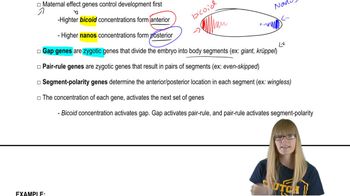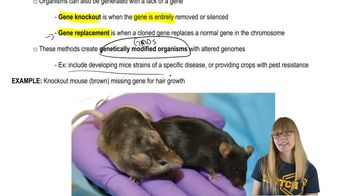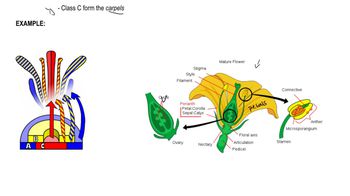Table of contents
- 1. Introduction to Genetics51m
- 2. Mendel's Laws of Inheritance3h 37m
- 3. Extensions to Mendelian Inheritance2h 41m
- 4. Genetic Mapping and Linkage2h 28m
- 5. Genetics of Bacteria and Viruses1h 21m
- 6. Chromosomal Variation1h 48m
- 7. DNA and Chromosome Structure56m
- 8. DNA Replication1h 10m
- 9. Mitosis and Meiosis1h 34m
- 10. Transcription1h 0m
- 11. Translation58m
- 12. Gene Regulation in Prokaryotes1h 19m
- 13. Gene Regulation in Eukaryotes44m
- 14. Genetic Control of Development44m
- 15. Genomes and Genomics1h 50m
- 16. Transposable Elements47m
- 17. Mutation, Repair, and Recombination1h 6m
- 18. Molecular Genetic Tools19m
- 19. Cancer Genetics29m
- 20. Quantitative Genetics1h 26m
- 21. Population Genetics50m
- 22. Evolutionary Genetics29m
14. Genetic Control of Development
Developmental Patterning Genes
Problem 8a
Textbook Question
Compare and contrast the specification of segmental identity in Drosophila with that of floral organ specification in Arabidopsis. What is the same in this process, and what is different?
 Verified step by step guidance
Verified step by step guidance1
Step 1: Understand the concept of segmental identity in Drosophila. Segmental identity in Drosophila is determined by a group of genes known as Hox genes. These genes are responsible for the development of specific body segments and ensure that each segment develops the appropriate structures.
Step 2: Explore the role of Hox genes in Drosophila. Hox genes are expressed in specific patterns along the anterior-posterior axis of the embryo, and their expression is regulated by a hierarchy of gene interactions, including gap genes, pair-rule genes, and segment polarity genes.
Step 3: Learn about floral organ specification in Arabidopsis. In Arabidopsis, floral organ identity is specified by the ABC model, which involves three classes of genes (A, B, and C) that interact to determine the identity of the floral organs: sepals, petals, stamens, and carpels.
Step 4: Compare the genetic mechanisms. Both Drosophila and Arabidopsis use a combinatorial code of gene expression to specify identity, but the specific genes and their interactions differ. In Drosophila, Hox genes are key, while in Arabidopsis, the ABC model genes play a central role.
Step 5: Contrast the developmental contexts. Drosophila segmental identity involves the development of body segments in an animal, while Arabidopsis floral organ specification involves the development of flower parts in a plant. Despite these differences, both processes illustrate how specific gene expression patterns can lead to the development of distinct structures.
Recommended similar problem, with video answer:
 Verified Solution
Verified SolutionThis video solution was recommended by our tutors as helpful for the problem above
Video duration:
2mPlay a video:
Was this helpful?
Key Concepts
Here are the essential concepts you must grasp in order to answer the question correctly.
Segmental Identity in Drosophila
In Drosophila, segmental identity is determined by a series of genes known as segmentation genes, which include gap, pair-rule, and segment polarity genes. These genes establish the anterior-posterior axis and define the identity of each segment through a cascade of regulatory interactions. The homeotic genes then specify the characteristics of each segment, ensuring that body parts develop in the correct locations.
Recommended video:
Guided course

Segmentation Genes
Floral Organ Specification in Arabidopsis
In Arabidopsis, floral organ specification is governed by the ABC model of flower development, which involves three classes of genes (A, B, and C) that interact to determine the identity of floral organs. Class A genes specify sepals, A and B together specify petals, B and C specify stamens, and C alone specifies carpels. This model illustrates how specific gene interactions lead to the formation of distinct floral structures.
Recommended video:
Guided course

Transgenic Organisms and Gene Therapy
Comparative Developmental Genetics
Comparative developmental genetics examines how different organisms use similar genetic mechanisms to achieve diverse developmental outcomes. In both Drosophila and Arabidopsis, gene regulatory networks play a crucial role in determining body and organ identity. While the specific genes and their interactions differ, the underlying principles of spatial and temporal gene expression are fundamental to both processes, highlighting evolutionary conservation in developmental biology.
Recommended video:
Guided course

Descriptive Genetics

 11:19m
11:19mWatch next
Master Segmentation Genes with a bite sized video explanation from Kylia Goodner
Start learningRelated Videos
Related Practice


